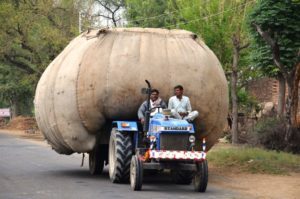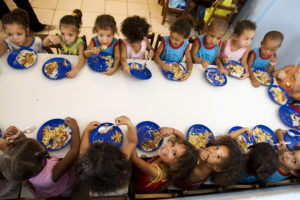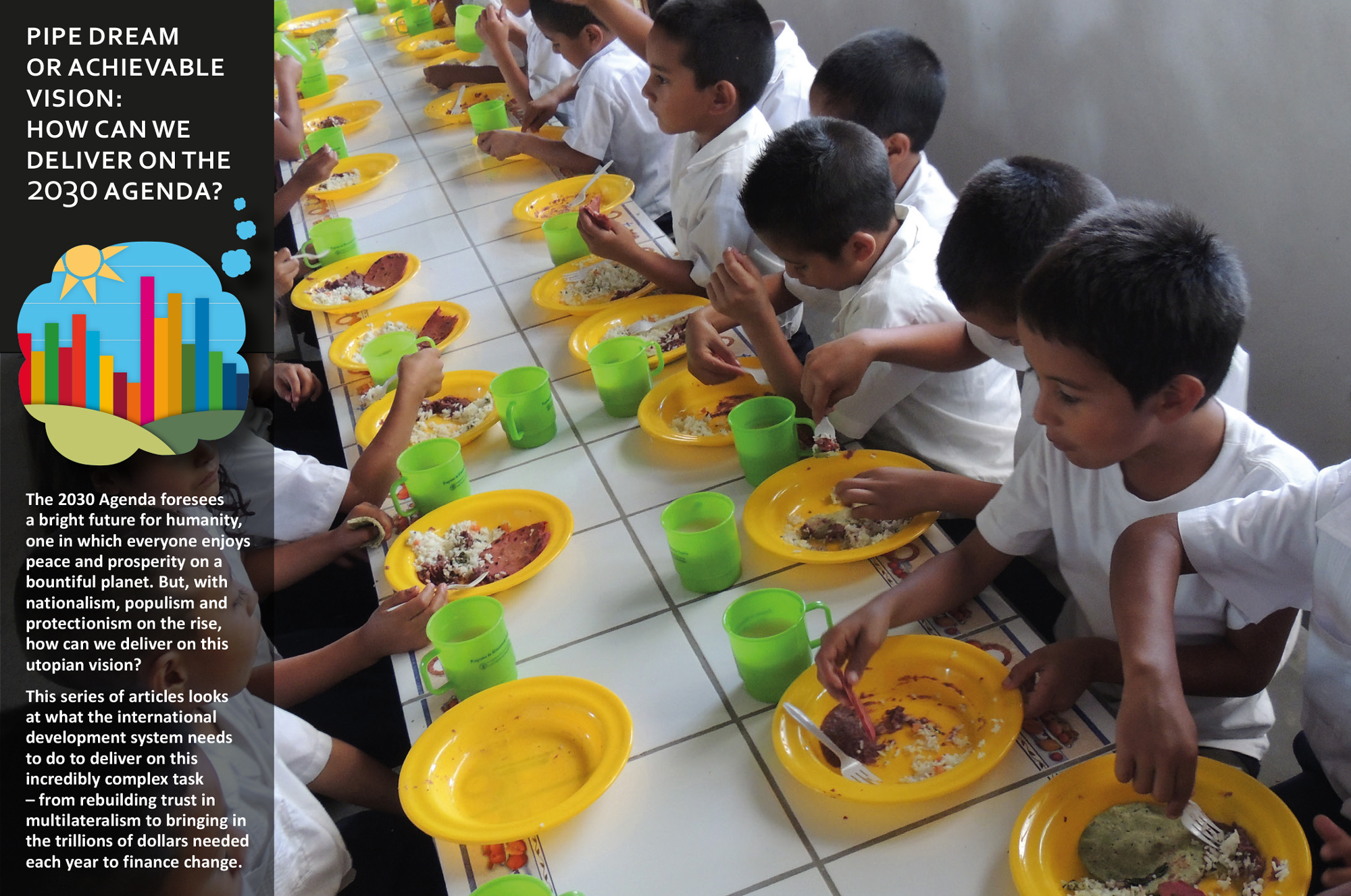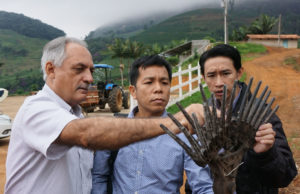SERIES TITLE: Pipe dream or achievable vision: How can we deliver on the 2030 Agenda? The 2030 Agenda foresees a bright future for humanity, one in which everyone enjoys peace and prosperity on a bountiful planet. But, with nationalism, populism and protectionism on the rise, how can we deliver on this utopian vision? This series of articles looks at what the international development system needs to do to deliver on this incredibly complex task – from rebuilding trust in multilateralism to bringing in the trillions of dollars needed each year to finance change.
Background
Some 93 percent of the world’s extremely poor people live in countries that are considered fragile, environmentally vulnerable or in protracted crises. Conflicts, fast population growth and climate change are among the causes of rising global hunger. In 2016, 815 million people were hungry and food insecure, an increase of 38 million from the previous year. With the global population expected to reach between 8.3 and 10.9 billion by 2050, the Food and Agriculture Organization (FAO) of the United Nations estimates that food and feed production will need to increase by 70 percent to meet the world’s food needs.
Emerging countries and the Sustainable Development Goals
At the United Nations Sustainable Development Summit on 25 September 2015, more than 150 world leaders adopted the 2030 Agenda for Sustainable Development, including 17 Sustainable Development Goals (SDGs) that are linked, either directly or indirectly, to food security and nutrition. The SDGs build on the Millennium Development Goals (MDGs), but have a more ambitious agenda, seeking to eliminate rather than reduce poverty and stressing the importance of health, education, gender equality, climate change, sustainable consumption, innovation, as well as peace and justice for all. A key enabler is financial inclusion, which guarantees that formal financial services are readily available to everybody.

IN THE PHOTO: Tractor transporting hay in Mandawa, a town in Jhunjhunu district of Rajasthan in India. PHOTO CREDIT: FAO/Philippe Ankers
With the adoption of the SDGs, countries have pledged to end poverty and hunger by 2030. This will be done in part by promoting inclusive, equitable and sustainable growth.
Emerging countries have a fundamental role in this context and economists believe that at least five of these, the so-called BRICS (Brazil, the Russian Federation, India, China and South Africa), closely followed by Argentina, Indonesia, Mexico, Nigeria and Turkey, could play an important part in the world economy and shape the nature of global development challenges.
As the International Food Policy Research Institute (IFPRI) declared in its report “The Role of Emerging Countries in Global Food Security”, China, India and Brazil currently participate in the new global economic reality and are considered true “agricultural powers” in terms of production, exports and imports. They have a say in trade negotiations at the World Trade Organization (WTO) and their decisions regarding their agricultural policies have a strong impact on international trade. In terms of food security, it is estimated that they will be key players in the world’s fight against hunger. Policies and initiatives to combat hunger and increase global food security are especially pertinent within these emerging countries, given the large share of the world’s undernourished people living there.
All three countries play a dominant role in the global production of staple crops such as wheat, maize, and rice, which have a critical impact on global food security. They have undergone a consistent and impressive growth in the agricultural sector since the 1970s, especially with regard to technological change, agricultural research, macroeconomic stability and institutional reforms. They have increased their agricultural spending in absolute terms since the 1980s and invested heavily in their agricultural research systems.
In addition, emerging countries increasingly affect growth and development prospects in developing countries directly, through aid, trade, and foreign direct investment (FDI), and indirectly, through commodity prices and competition in third markets. Their technologies and know-how have already been extended to other developing countries; China has set up many demonstration stations, and Brazil has introduced several initiatives to transfer their respective technologies to Africa.
IN THE PHOTO: Qingtian Rice-fish Culture System PHOTO CREDIT: FAO of the UN via Flickr
Since 2007, the global economy has entered a transitional phase. Retailers see emerging markets, with their rapidly growing consumer demand, as a more attractive opportunity for growth. Consumer spending in the United States and in Western Europe has steadily declined and has been eclipsed by that of emerging markets, most notably Brazil, Russia, India and China; this trend is expected to continue. As more Chinese and Indian families enter the ranks of the upper-middle class, status-related spending behaviour may become more widespread and could further alter the composition of global consumer markets.
Trade relations with emerging countries have a significant food security dimension. Increasing trade with emerging countries offers developing countries the opportunity to expand markets for exports and to obtain cheaper imports. China, India and Brazil are among the major exporters of a number of major food crops, and as a result, their export and production policies have a significant effect on food prices and supplies in many developing countries and affect all international trade. It may, therefore, be advisable for the international community to establish regulatory mechanisms to anticipate and respond to any unilateral decisions made by one of these EEs, which could potentially disrupt all international markets. There is also a need for greater transparency in agricultural production levels, and an effective warning system, coordinated at the highest level by competent bodies.
Challenges in the fight against rural poverty
All the Emerging Economies (EEs) had relatively high growth rates prior to the Great Recession in June 2009, and this enabled them to achieve progress in their fight against absolute poverty; a fight that met with varying degrees of success because of divergences within the country. The main disparities are inequality in income levels, a large and persistent informal sector which effectively excludes workers from social protection regulations, erratic access to education and to basic services, difficulties for women in obtaining employment and progressing in their careers, ethnic, as well as regional differences.
IN THE PHOTO: FAO Indigenous Peoples’s team shared its joint work with indigenous peoples in the celebration of their cultures and traditional food systems in Meghalaya, North East India. PHOTO CREDIT: FAO
Climate change, population growth and migration are putting disproportionate pressure on the rural poor. Climate change affects agriculture and food production, safety and security in complex ways, both directly through changes in agro-ecological conditions that also make affected populations more susceptible to infectious disease and indirectly by influencing growth and the distribution of incomes.
Rural families increasingly depend on non-farm incomes. When infrastructure or basic services are lacking, credit is difficult to get and institutions are weak, small rural enterprises and earners of non-farm wages are the hardest hit.
Without social protection, the poor are the most vulnerable, especially the elderly and the disabled. Rural women and members of female-headed households also struggle to maintain substantive livelihoods as they tend to face discrimination in accessing productive resources, such as land, extension services, technical training and markets.
The role of agriculture in reducing rural poverty
Investment in agriculture is the most direct route for rural people to benefit from their main assets: land and labour. However, in order to reduce rural poverty, it is important at the same time, to increase the productivity of small-scale farms, promote more efficient value chains, create jobs, especially for youth, and encourage economic diversification.
For poverty solutions to be effective in the long term, agriculture and rural livelihoods must take into account the sound management of natural resources and biodiverse ecosystems. If these natural resources are poorly managed and depleted, they will no longer be available for future generations.
Rapid economic growth can help reduce rural poverty, but this is only possible when national policies pay sufficient attention to improving agricultural productivity and rural infrastructure, facilitate access to social services and social protection, promote the development of rural producer and consumer organizations, and address women’s specific challenges in accessing productive resources and social services.
IN THE PHOTO: Experts from the Ministry of Agriculture and Forestry of the Lao People’s Democratic Republic participate in a study tour in Brazil facilitated by FAO. The Laotian experts learnt from their Brazilian hosts how to better integrate farmers to markets through successful contract farming practices, in order to enable inclusive and efficient agricultural and food systems in their country. PHOTO CREDIT: FAO /Alberto Trillobarca
Preventing recurring famines and building resilient food systems
Some countries face recurrent famine-like conditions due to low levels of resilience in their food systems. Resilience building requires a transformation of the food system, sustained investment in agricultural research, extension and rural infrastructure, combined with improved social safety nets. Countries that have strong assessment, monitoring, and surveillance systems to minimize the risk of food crises and mitigate the effects on the vulnerable, and countries that have organized capacity for collecting, analysing and designing interventions can manage impending disasters better than others. Famine prevention can only be effective if decentralized institutional and human capacity is built to forewarn, plan for, and manage disasters.
The way forward
The building of long-term food security calls for an integrated approach encompassing agriculture, health, nutrition, public works and rural development. But it does not exclude traditional approaches in the short term, such as:
- Humanitarian aid, targeted food aid, together with the provision of healthcare, clean drinking water, and sanitation.
- Rebuilding communities through safety net programmes such as public works and restoring food production through the distribution of inputs, including fertilizer and high-quality seed.
- Strengthening local food system resilience by providing communities appropriate, up-to-date crop technologies and ensuring that they are adopted; strengthening institutional support for research, agricultural extension services and policy making.
- Focusing on long-term economic strategies. Fostering of economic diversification and expansion of employment opportunities, as well as investments in microcredit programmes, market development and long-term agricultural research, create an enabling environment for food security.
Any long-term solution, however, will depend on a sustained commitment to rural development and food security on the part of policymakers, development partners and the affected countries themselves, as well as on the suppression of armed conflicts in some of these countries. All interventions will need to be carefully planned, executed and monitored to determine how best these strategies may be adapted to the 2030 Agenda for building better-governed, famine-resistant communities. The eradication of famine can only be achieved through the eradication of social and political inequality.

IN THE PHOTO: Students and farmers benefit from School Feeding Programmes. PHOTO CREDIT: FAO /Ubirajara Machado
Aligning emerging countries’ priorities with Agenda 2030
At an event organized by the World Resources Institute (WRI) and the Governments of Colombia and Switzerland during the UN Summit for the adoption of the post-2015 development agenda, four key points were highlighted as vital to accelerating the adoption of the SDGs at a national level:
- Evaluate and align strategies
Governments need to align their own national priorities and plans with the 2030 Agenda for Sustainable Development by identifying synergies and any critical gaps, assessing what adjustments need to be made and what level they wish to achieve. It is essential to engage the private sector, civil society groups and political leaders in this endeavour, and to set intermediate targets if required.
- Make policies more coherent
While development aid remains critical, it is equally important to ensure that policies do not undermine aid objectives or stifle domestic progress.
It is necessary to create the right enabling environment for private-sector investment. Some industries’ actions may serve to weaken foreign markets, adversely impacting multiple goals; public policies leading to sustainable, equitable and inclusive growth are therefore crucial.
- Integrate economic, social and environmental decision-making
To put the SDGs into practice, countries need to go beyond the traditional view of development.
- Retain the SDGs’ core principles of inclusion and universality
The SDGs are built on the concept of shared destiny. They can only be achieved through the participation of all countries and a sense of ownership.
When formulating policies, governments should have the licence to adjust the SDGs to fit national contexts, and they should be assisted in this endeavour by local and non-state actors, businesses and ordinary citizens, so they too can own this agenda and take it forward, ensuring that no one is left behind.
IN THE PHOTO: Farmer cooperative beneficiary of an FAO Climate Smart Agriculture project in Kaixian (Chongqing Municipality) and Hunan Province. PHOTO CREDIT: FAO /Alessandra Gage
Targeted action for an ambitious agenda
Although the SDGs have a broad, multilateral agenda, leadership at the national and local levels, as well as coherent policies and planning are called for, to amplify the impact of both financial investments and development outcomes. It is now up to the global community to meet the challenge of translating vision into action, bearing in mind that on the path to sustainable development, all countries are interdependent. We share a common goal and a common destiny and it is up to all of us to contribute to its success.














